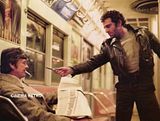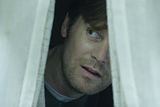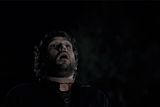“We got hell here,” old man Balsam says to old man Bronson, returning home the prodigal son to New York City and he ain’t kidding: these ravaged streets look like the badlands of Deadwood, the bombed-out edifices of war-torn Iraq, or Brooklyn’s Nostrand Ave. Rampant violence in open daylight and cops of Keystone variety just drive by. Multiracial gangs dressed like Little Rascals, led by Nosferatu with a backward Mohawk – barber misunderstanding the guy and I’m sure he was killed shortly thereafter. Extortion at will, an elderly thug picking at plaque with the barrel of a .357 and everyone listens to Jimmy Page. This the milieu and here we go – our hero, once Conscientious Objector, now bold Black Angel of Death arriving just in time.
Bronson: “What about the cops, they do anything?”
Rodriguez, nice Rican neighbor (given last name only, presumably out of respect for the character’s Latino heritage): “Yeah - they enforce the parking laws.”
Nefarious miscreants bust into respectable senior citizens’ homes through the fire escape at any given time of day – ex-architect Bronson fortifies apartments in much the same way young Kevin will the family house in Home Alone:
Balsam: “What’re you doing?”
Bronson: “Thinning the herd.”
All culminating in a full-scale uprising bearing startling resemblance to the L.A. riots – brutal beating of a Caucasian male passerby, stoning of police vehicles, looting, pillaging, buildings on fire, flames eight-stories high.
I remember thinking these films cheap, cheesy and crude initially. It was only after reading Brian Garfield’s original Death Wish novel (which had its own, more thoughtful literary sequel, entitled Death Sentence) some years ago that I observed the first.
One of the best American films of the 70s, Death Wish belongs with Taxi Driver, The Exterminator, and Bad Lieutenant as mad, sad, urban feverdreams, sharing a same sensibility, one both distinctly New York (paranoia, sense of irony, knowledge of neighborhoods, subway lines, history and general way of city life) and male. Anti-hero myths, “Movie” movies masquerading as social commentary (unlike, say Norma Rae or Serpico).
It can further be categorized, along with Electra Glide in Blue and Easy Rider, as time capsule for The Way We Live Now and Why (the recent Crash seemed to want to be in this family).
Acting (here, Bronson – less an actor than a presence – attempted a performance, his character subtle and nuanced; it was something like Clint in Unforgiven, coming at it with all that tough guy, man-of-action baggage and flipping it, making it mortal), score (one-time Miles Davis protege Herbie Hancock), direction (Brit Michael Winner would go on to pimp the next two sequels, but here his work was sound; moody, unflinching, satiric when necessary – a handsome shot of a clean, sunny New York and the camera zooms out to reveal it’s a postcard, the picture-perfect tourist façade portrait sitting there in the midst of the cesspool that is the real one), script and locations conjoined to form a solid, satisfying slab of concrete.
Plus that killer parting shot, rivaling another ‘70’s New York classic, The Taking of Pelham 1-2-3.
Bronson’s grief here was palpable – though not as much as in the book, there sad to the point of unbearable – and we watch a process occur, an arc to our unstrung hero; gradual escalating real-world behaviour (his first weapon is pitifully makeshift – a sock full of quarters; after the first killing, Bronson scurries home to his bathroom and hurls), change that made sense. We could relate and so were involved emotionally in it and not just observing. Presenting a moral conundrum, as we invariably, vicariously experienced the thrill of baiting, then offing convincing street punks (like Welcome Back, Kotter’s Washington) in real-world settings (Washington’s scene in Central Park, the film shot entirely on location in New York City, with a brief but crucial jaunt to Arizona).
The violence here hurts – Bronson gets cut (his first war wound) and winces, breathing irregularly while tending in real-time to his injury, and that hard and tragic and funny irony is there – this civilized, mild-mannered businessman nursing a stab wound the mugger he murdered gave him just before dying.
Released during our Nixon/Ford era, the film caused a stir, inspiring outrage and debate. Not so for its children, however; Death Wish II, released during Reagan’s first term, was trashed and any subsequent additions ignored, diminishing any respectability toward the original.
Part two indeed utterly reprehensible, but in a nihilistic enough way to have invited my affection – those scenes of him hunting, dressed in black, knit hat pulled down to his brow, beady eyes scanning dark shadows; steady tracking shots through the crime-ridden, seriously rat-infested underbelly of downtown L.A. at night, scored to Jimmy Page and Gospel hymns emanating from ghetto storefront churches next door to liquor stores and hock shops; a decade since my last viewing and I remember these details.
You want violence and urban decay, we got both like a muh fucka and, to be sure, this one basks in it confidently, tactlessly, unapologetically, almost gleefully, and there’s something to be said for that. No character development, only brief setup and payoff, all gratuitous and not just a little akin to a slasher film, only grittier and more mean-spirited.
By Death Wish 3, we’ve an invincible automaton, downright psychopathic, dispatching vengeance in a clinical manner with nary a quip – not Bronson’s style, baby. Exterminate with extreme dispassion.
No conflict or complexities here, the message simple: early on, a shot of a cockroach scurrying across the floor, the corrupt police lieutenant on whose side we’re supposed to be stomping it with his shoe and saying, “Cockroaches – I hate em.”
Later, he’ll smash one against the wall with bare fingers and ask Bronson to cool it for a few – too much heat comin down, y’see – which Bronson will refuse, saying, “It’s like killing roaches – you have to kill em all, otherwise, what’s the point?”
Bronson now a vigilante by profession, blackmail-hired by aforementioned police lieutenant to “take out the trash” his men cannot. Tools of trade including a Wildey Magnum (“a shorter version of the African big game cartridge” – bullets the size of your middle finger) and a couple heavy-duty vintage machine guns need two strong arms to hold. Plus a missile launcher.
One long commercial for the NRA, by the film’s climax, all formerly terrorized residents will have procured guns – some pried from the clutching hands of dying thugs they themselves have killed – and used them without trepidation, running rampant through rioting streets, shooting indiscriminately at minority youths, ostensibly taking back the night.
Fire with fire – “Exterminate all the brutes.” (Joseph Conrad, Heart of Darkness)
Page’s nervy, wall-to-wall score (lifted from part two) lending the only edge to a cynical venture.
Yet, there is also something to be said for cold simplicity. Produced today, you can be sure them three seconds it takes Bronson to load would be drummed into its own action sequence – two-thousand cuts deep, shot from every angle and with a glossy sheen so beautiful you’d want to eat or fuck it. Each punk shot receiving his own thunderous movement, jacked up camera in constant motion, low-angle tracking shots, triple-extreme hand-held close-ups cascading into a climax with said punk’s towering body and Bronson’s ejected cartridge intercut as they descend to the ground, bouncing twice before lying still, crashing music score quelled to silence, followed quickly by a throwaway quip, bring us all back from melodrama.
Bruckheimer bombast, sound and fury signifying Peckinpah spitting out his cigar and rolling in his grave.
All the carnage occurs here, it’s the women who suffer most; Rodriguez’ wife, for example, despite having zero lines, will be kidnapped, beaten, gang-raped and murdered, making it personal for our once cheery, now devastated token Rican (who weeps in his sombreros-ridden apartment – no joke). Females are victims only, occasionally used as pawn – you’re a hoodlum and an old guy threatens your rep, your very manhood, you rape his lady, maybe punch her in the face, blow up his car while she’s passed out in it.
Us men have a bloodlust and an insecurity that cannot be denied and without them traits, these men – Bronson, Eastwood, Norris, Seagal, Joel Silver – would not have had careers.
Thus the message of Death Wish 3 (“Screw complicated Roman numerals,” said marketing) is simpler, even more Republican-American than “an eye for an eye”/ stomp all minorities and liberals. Said message: I am here to make money, and exploiting your basest fears and fantasies is how I’ll do it.
At one point, Bronson chidingly asks fellow Korean war vet Balsam, “This is America, isn’t it?” while concealing the massive Magnum behind his back.
Balsam’s look is troubled, but in case there be cast doubt, the American flag hung (droopily) in the corner of Bronson’s bunker confirms it.
(To be filed under Meaningless Trivia is the Goldblum-Fishburne connection: Jeff in number one, ruffian leader knocks Bronson’s wife out, then supposedly "paints" his daughter’s face, leading her to catatonia; Larry/Lawrence in number two, wiry follower likes to fiddle with a hunter’s knife, joins in gang-raping Bronson’s Mexicana maid, murdering her afterwards, then kidnapping his still-catatonic daughter, gang-raping her as well, and yes, killing her dead in the afterglow. Auspicious beginnings.
They would later unite for Bill Duke’s smart, half-blazing, half-familiar Deep Cover [co-written by novelist Michael Tolkin], which would contain career performances from both and whose score would be snarkily built around direct samples of Page’s fuzzy, frenzied, lunatic riffs from number two. And everything comes full circle.)
- from May of 2005











